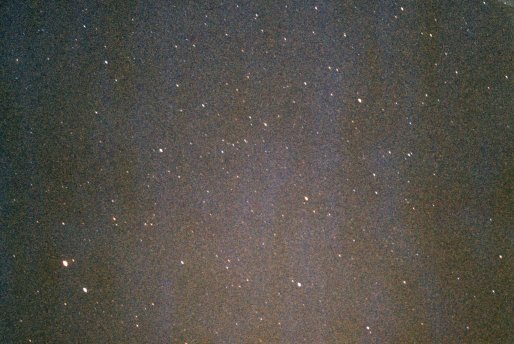 The most prominent part of Virgo, the Virgin, spreads to the
northwest (to the right) of the first magnitude star Spica, the
fainter of the two bright bodies at the lower left corner. The
brighter is reddish Mars, which moved through Virgo in the summer
of 1999. North is up and to the right. To the right of center, a near-vertical line of
three stars curves to the right, Vindemiatrix on top, Delta in the
middle, Porrima
at the bottom. Porrima and the star down and to the right of it
point at the autumnal equinox. Well up and to the right of Spica
is Heze (Zeta). 78 Vir is the second star up and to the right of Heze,
while Tau Vir is up and to the left. Theta lies between Spica and Porrima.
Equally down and to the right of Vindemiatrix
find Rho Vir closely accompanied up and to the right
by 27 Vir, 33 Vir to the left of them. CU Vir is up and to the right of Tau.
Sigma lies just above the picture's center,
while Iota, Mu, and 109 Vir are off the pictue to the left in
eastern Virgo.
The most prominent part of Virgo, the Virgin, spreads to the
northwest (to the right) of the first magnitude star Spica, the
fainter of the two bright bodies at the lower left corner. The
brighter is reddish Mars, which moved through Virgo in the summer
of 1999. North is up and to the right. To the right of center, a near-vertical line of
three stars curves to the right, Vindemiatrix on top, Delta in the
middle, Porrima
at the bottom. Porrima and the star down and to the right of it
point at the autumnal equinox. Well up and to the right of Spica
is Heze (Zeta). 78 Vir is the second star up and to the right of Heze,
while Tau Vir is up and to the left. Theta lies between Spica and Porrima.
Equally down and to the right of Vindemiatrix
find Rho Vir closely accompanied up and to the right
by 27 Vir, 33 Vir to the left of them. CU Vir is up and to the right of Tau.
Sigma lies just above the picture's center,
while Iota, Mu, and 109 Vir are off the pictue to the left in
eastern Virgo.Off the picture to the right lies western Virgo and the Autumnal Equinox, where they are seen in context with Leo, Coma Berenices, and Leo Minor. Diadem, the Alpha star of Coma Berenices, is near the upper right corner.
